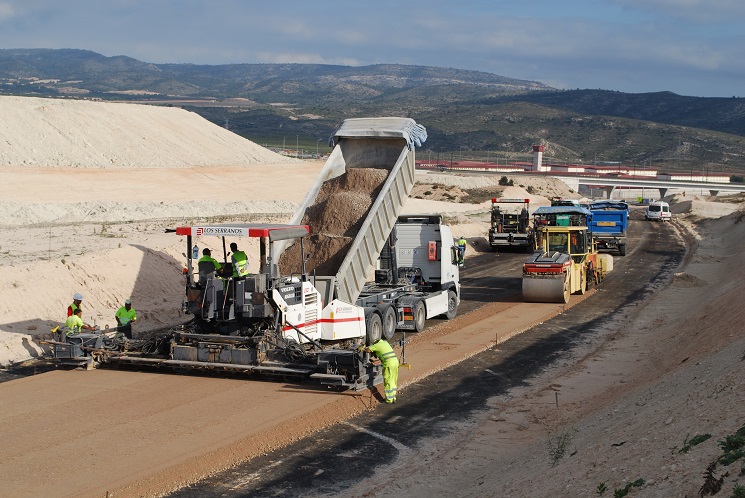The paperChain project launches the third pilot in La Font de la Figuera variant (Valencia) to improve the sustainability of roads by implementing ashes
This third pilot, consisting of the execution of 500 m linear soil-cement layer on a service track of the La Font de la Figuera motorway, Valencia, will demonstrate the feasibility of completely replacing cement with fly ash coming from the energy recovery of paperwork rejections.
The paperChain project will launch its third pilot on a service road on the La Font de la Figuera motorway, Valencia. Among other objectives, the project aims to reduce the environmental impact of road construction by replacing cement with ash from the paper recycling process.
This new test will try to demonstrate that cement can be replaced with ash in the soil-cement layer, which is the one directly under the asphalt and withstands most of the vibrations of heavy traffic, without affecting the safety of the pavement. Initial tests carried out at the Technological Centre of ACCIONA Construction have shown that 3 % by weight of cement in this layer can be replaced by 5 % ash complying with ample safety margin all the technical requirements established by the Ministry of Development.
In addition, the pilot will demonstrate that this substitution does not affect production, which is compatible with the machinery currently used to produce and extend the mix on the roads. In addition, its long-term monitoring and comparison with sections executed with cement will allow to visualise any relevant differences.
To date, two pilots have already been successfully overcome, in Ejea de los Caballeros and Villamayor (Zaragoza), where it has been found that this substitution is technically and environmentally viable in the lower layers of the road (Stabilised layer S-EST2 and S-EST3 type according to the Spanish road regulation).
The initiative, coordinated by ACCIONA and with the cooperation of the Saica Group, the Polytechnic University of Catalonia and the road laboratory of the Government of Aragon, is funded by the European Commission under its Horizon 2020 programme. In addition, with the support of the Ministry of Development.
A complete recycling process
The use of ashes as road material is only the last step in the important cycle of Circular Economy and Sustainability that forms the paper recycling industry. Firstly, cellulose fibres are recycled numerous times even because of their length cannot be reused, where they end up as sludge in water purification plants in recycling centres. In addition, traces of plastic and other materials other than paper but present in the recovered paper are removed during the manufacturing process, forming another part of the waste generated.
At present, this volume of sludge and plastics can be reduced to only 12 % through its energy recovery, producing electricity. This process also makes it possible to recover ferric and non-ferrous metals, so that only a residual flow of ash from the combustion of these sludges and plastics is destined for landfill.
This process is carried out in the energy recovery plant that the Saica group has at its plant in El Burgo de Ebro (Zaragoza). With a power of 49 MW, the installation allows the production of energy while reducing the waste stream of the paper recycling process that ends in the landfill; In particular, the 400,000 tonnes of waste that ended up in landfills have been recovered and the landfill has been reduced to about 45,000 tons of ash.
These ashes have a great interest as a substitute for cement on roads because of their binding properties. Even if we don’t see it, our roads carry significant amounts of cement under the asphalt. A single kilometre of motorway may require several thousand tons of cement, one responsible for the emission of greenhouse gases.
Cement and to a lesser extent lime are widely used to improve the mechanical properties of the soils used in the different layers that form the roads, increasing their durability, reducing their thickness (and therefore consumption of raw materials) and allowing the use of materials from the excavations of the road itself which, because of their poor mechanical properties, would go to landfill.
To learn more about the paperChain project, please visit www.paperchain.eu.

